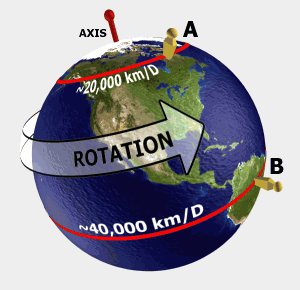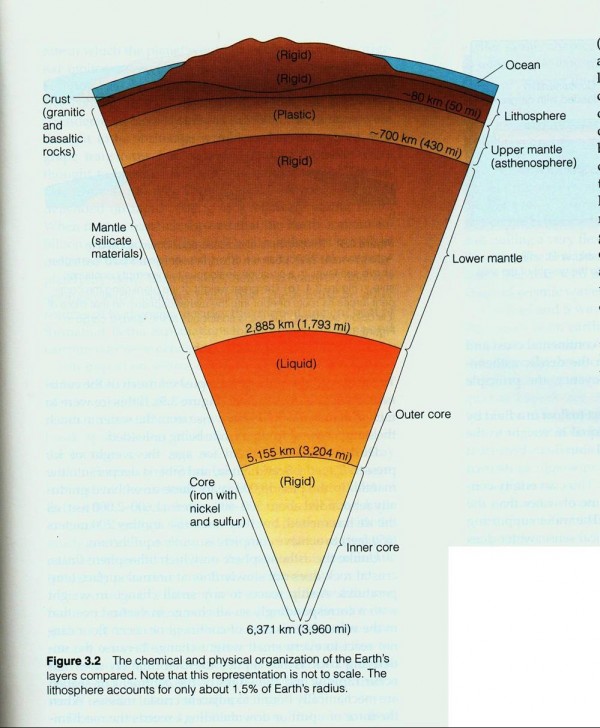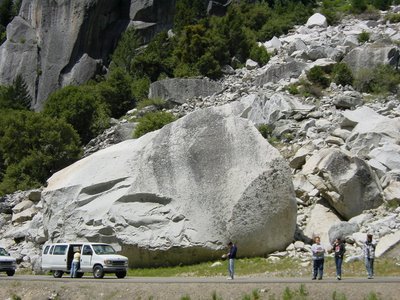"You can no more win a war than you can win an earthquake." -Jeannette Rankin
As you all surely know, an 8.9 magnitude earthquake just struck Japan, devastating the island of Honshu.
Ask a geologist, and they'll rightly tell you about plate tectonics, subduction zones, fault lines, and much, much more. But there's a simple physics reason that they happen underlying all of it.
The Earth is built like a giant, spherical layer cake. The inner core -- made up of mostly iron and nickel -- is the densest of all the layers, while the lithosphere -- the Earth's crust -- is the least dense.
This, by the way, is good.

Compare the left and right images, above. If I asked you which one was more stable, you'd immediately tell me the one on the left, obviously. Physically, this is because the more mass you have closer to the center of gravity, the more stable you are!

So this means, if we want the most stable Earth possible, it would be a perfect "onion", with the densest, heaviest elements being concentrated at the center, and then -- with each outer layer -- a progressively lower and lower density. And it wants to be like that, packed as tightly as possible, the same way that a stone sinks in water, an iceberg floats on an ocean, or a helium balloon rises in air.
And, unfortunately, the Earth is not in its most stable possible configuration right now. But, over time, gravity is doing everything it can to help it get there. How? By bringing denser, more massive chunks closer to the center, and uplifting lighter, less dense pieces.
And that's what happens -- energy-wise -- every time we have an earthquake! In physics terms, we're keeping the mass the same, but rearranging it, which changes the Earth's moment of inertia.
Now, the more astute among you will immediately think of a consequence of this, if this is what's really happening. You see, the Earth is spinning, and you know what happens when spinning things change their moment of inertia.
The more mass you bring closer to the center, the faster it will rotate! For a figure skater, above, this means that bringing your arms and legs closer to the center causes you to spin faster.
For the Earth, this means that after every earthquake, tremor, or aftershock, the whole planet should start spinning slightly faster.

And it did. The Earth's rotation is now 1.8 microseconds faster than it was before the earthquake on March 10th/11th (depending on where in the world you were), and most of that has happened because the Earth's radius is now just a tiny bit smaller after the quake.
And this isn't the first time that's happened, either. According to figures from CBS news,
The 8.8-magnitude earthquake in Chile last year also sped up the planet's rotation and shortened the day by 1.26 microseconds. The 9.1 Sumatra earthquake in 2004 shortened the day by 6.8 microseconds.
These might seem like tiny, tiny amounts of change, they actually correspond to a huge shifting in mass: something like moving more than 10 billion tonnes of rock from the crust of the Earth to its center!
And until we reach this theoretical "most stable configuration possible," the Earth will remain geologically alive, quaking and shifting, and speeding up its rotation each time it does!
And for those of you who are celebrating Pi Day, check out this amazing visualization! (You may need to click on the Visualizing Pi link after a redirect, depending on your browser.)







WTF?
Without mentioning convection (that moves the masses away from the most stable configuration) none of this makes sense. You need an energy source to drive the whole thing over geological time.
In Britain, we celebrate Pi day on the 31st April. I mean, the 3rd of... oh, never mind.
when oceanic plate material reaches the surface and cools, it contracts. Also there's a bizarre thing related to the crystals with lower melting temps having higher density (some of them) So the oceanic crust is denser than the material underneath it. On the other hand, continental crust, like the stuff in your last picture, is lighter (so continental crust doesn't subduct; it rises like himalayas). So as long as there's a heat source from below, there will be plate tectonics.
Where's the heat come from? That's a good physics story. radioactivity in the core, keeping the inside of the earth molten so that the plates can move around. Back in the 19th century physicists thought the earth couldn't be old, because it would have cooled off (they didn't know about radioactivity).
I was discussing the earthquake the other day with someone and while I provided the non-conspiratorial, science based interpretation of events, he insisted that I was only giving a geologist's point-of-view and not an astronomer's, and he further added that there is a solar wind factor, likely because he had seen this video:
http://www.youtube.com/watch?v=u_HLj2Q_B4I
My BS-O-Meter went off like crazy when watching this, what do you think? Note he also provides astrological charts, which pretty much sums it up for me.
I'm not a scientist, but I'm lucky to have one personal friend who's a physical chemist, and one who's a geologist. So, between my dear friends, I've got access to the full spectrum from quantum mechanics to earthquakes.
It's not so much physics trumping geology, but physics, chemistry, geology, astronomy, astrophysics, and cosmology all engaged in the same business at different scales.
The closeness of mass to the center of gravity in your cone doesn't change when you invert it, though the cone is certainly more stable when the center of mass is lower.
Also, is the Earth really tending toward "a most stable configuration"? I would think that in the long run earthquakes would in effect balance slow movements such as thermal convection in the mantle with an opposite tendency.
In the first link that Ethan provides,of part one,in the tenth picture (Ishinomaki in Miyagi)
For what purpose does the blue blocking at the far left in the after picture appear?
The area looks like a sewage treatment plant, but what of those containers, most of which have been blue blocked yet you can still see remnants in the solid waste dispersal fields to the right.
Does anyone know what is in those containers?
Of part two, in the eleventh picture someone has scribed an SOS in the high school soccer field...such devastation, I hope help reached or reaches them asap.
Why do you ignore the portion of the convection cells that lift heated material to the surface at the spreading zones? On average they balance the sinking of cold material as it is subducted back down. It is the same material, changing in density only with temperature.
Yes, the big subduction quakes produce a measurable decrease in the period of rotation, a neat demonstration of angular momentum at work on a large scale and the precision of modern measurement techniques.
We can also measure the slow rise along the fault line that precedes the next quake, resulting in a zero sum displacement. To the extent that cold dense oceanic plate moves down suddenly during the quake, it is compensated for by the same material continuously rising in the spreading zone. Therefore no net change.
Very long term, the planet will shrink due to cooling and that will make its contribution to the angular momentum.
Brilliant explanation. Never thought of it like that.
By the way, you show the lithosphere and the asthenosphere, but where's the blogosphere?
Last I knew, crustal plate movement is conjectured to be driven by convective cells in the mantle, with the ultimate energy driver being pent-up heat from the decay of radioactive isotopes. It also seems that due to these isotopes the Earth cannot reach thermal equilibrium even though it "tries" to do so. And because continental material is being continuously subducted and driven down into the mantle, the heat from its radioactive isotopes then becomes trapped again, forming the genesis of another convective cell. Since the Moon definitely does not do this and Mars does not either, I'd have to ask our qualified astronomical geologists what would explain this anomaly about Earth.
To make my query more usable: Are there any other planets and/or moons that exhibit plate tectonic movements similar to Earth? None of the other planets seem to. Io seems to be due to tidal forces, also Europa, which does not explain Earth's. Why are we so different than Venus, Mercury and Mars? They should have about the same complement of radioactive minerals in them (Mercury seems to have lost a lot of its plagioclase outer shell, but not Venus and Mars). Why do Venus and Mars not have convective cells in their mantle like Earth?
Another way to express this, in terms of subducting plates, is that the potential gravitational energy of a 'hang-up' on the Pacific Plate was released in a few seconds on March 10/11, and the mass of the plate moved closer to the center of the Earth very quickly. If the crustal plates were nice and rubbery and fluid and not jaggly and brittle, these movements would be so gradual as to be imperceptible; similar to the tiny but observable spreading of the Mid Atlantic Ridge which is pushing North America and Europe apart a centimeter or so per year, without earthquakes.
From what I've been told by a drunken geologist, there's not a good answer to it yet, but he thinks that it's from the collision with a Mars-sized body that's supposed to have created the Moon. The Earth got the other body's entire metallic core, leaving the Moon without a substantial one, and the Earth with an especially large one, giving our planet tectonic activity, a magnetic field, and volcanism, well after the other planets in the Solar System have gone "dead", so to speak.
Though, again, this is what I tried to glean from an already-fairly drunk geologist.
Brett @3: About a minute into that video, the narrator says that the coronal hole on the Sun resembles the Asian coastline. That was all I needed to confirm that the idea is complete BS. There may be further earthquakes in Japan, but not for the reasons he seems to be blathering about.
Solar wind and earthquakes are both lumped under the rather broad heading of "geophysics", and some general mathematical techniques are applicable to both. Other than that, they have nothing in common.
Evan @12: For the record, Mercury has a magnetic field (which is just barely strong enough to stand off the solar wind under average conditions), and Mars has both crustal remnant magnetic fields (with suitable geometry to produce localized aurora in certain locations) and extinct volcanoes (notably Olympus Mons). There may be something to the explanation your geologist friend gave (IANA planetary geologist, so all I know is what I read in the papers), but it's not the whole story.
Evan @12:
I want to go to parties where there are drunken geologists.
Several years ago, during a dinner at a physics conference, someone posed a neat riddle: what physical changes have we made to the Earth over the last 100 years that has measurably altered the length of the day (I assume they meant it's measurable in theory, meaning our measurements are sensitive enough to detect the theoretical value; in practice I think there is a lot of noise in the signal...).
The answer was dam building, and I thought they said it was about 1/100th of a second over the last century, but now that seems kind of high, considering these quakes only change it by a few parts in a million. But I don't know; I don't have much of a feel for the quantities of water we've collected. I've never taken the time to work any of this out myself, to check for reasonableness.
Wait, I think I get it now: the 1/100th of a second over a century literally meant if you hadn't made the change, the Earths rotation would be 1/100th of a second off after one century.
I forgot to mention, saying "The Earth's rotation is now 1.8 microseconds faster than it was before the earthquake..."
isn't as unambiguous as: "...shortened the day by 1.26 microseconds" /end nit-pick
about Pi day: we should celebrate Tau day, June 28, instead. get rid of all the 2Ï in formulas!
up with Ï and down with Ï!
umm...wait. what would we eat on Tau day? we couldn't eat pie...never mind!
Nice explanation. I learnt so much. Now my view has changed about quake in general. Although quake is natural for our home planet earth, It is a catastrophic event. I think we are not ready enough to get along well with it.
As I understand, Mercury today is not quite, but mostly the iron and nickel rich core of the planet, the lighter silica rock being wiped out by early collisions. What's interesting to me is that we don't really know how big the inner planets 'were' upon initial concretion vs. their size after later bombardment. Assuming that the inner planets all originally had a fairly similar content, the bombardment period would seem to be the only explanation for their current differences. As a side note, I'm wondering if there is any connection between Earth's active plate tectonics and that it has life, vs. Mars which has neither. Does life in some way require a dynamic crust and mantle?
Brett and others;
I watched as much as I could of that video, while the notion may be somewhat correct, it is not correct, it is too simple, there is not a primary single reason, as one would derive from that speculatory vid.
However, we are only beginning to comprehend Sphere Coupling and the intricate compound intermixing relations of our systems within systems, there are countless such couplings thruout.
The following link will give you good perspective on such couplings, tho I have to report a direct linkage/coupling to earthquakes is still quite obscure!
I'd like to take this opportunity to give acknowledgement to NASA and all the institutions dedicated to Heliophysics and it's couplings...keep it up!
http://www.vsp.ucar.edu/Heliophysics/pdf/Lecture%207%20Kozyra.pdf
It is a core to core relationship between the Sun and all solar system bodies.
This topic is still in it's infancy, Sphere coupling involves the coupling of fields or trades, such as biology and particle physics, etc.and it demands cooperation at a very high level.
There are so many undiscovered couplings that this combination of professions can't help but expand in the future, it is all encompassing and diverse in ways that would seem extraordinary, I wish I were a young person just entering this field...what a ride you have in store for you!
http://www.vsp.ucar.edu/Heliophysics/science-resources-presentations.sh…
This is an extremely interesting article. I actually had no idea that the Earth used earthquakes to rearrange itself. I always thought that earthquakes just happened when different tectonic plates collided with each other. Then again, I also havenât take physics yet, so I didnât realize that Earth wasnât in its most stable configuration. This article also interested me because I have second-cousins who were in Japan at the time of the earthquake and tsunami. Theyâre OK, but it still gave me a bit of a scare. Itâs nice to know what actually causes earthquakes, so more research can be done on them, and more preemptive warnings can be given.
its quite an interesting phenomena indeed and this site gives a clear and precise spectrum of what is happening.thank you
WOW WOW WOW WOW WOW WOW OWOW
great read i didnt realize that the earth was haveing so many earthquakes to rearange itself either. But i have heard of the damn topic you brought up aswell.
Sorry, one thing I've forgotten: my post mentioned in the previous comment is in German only, but the linked texts are English.
I heard that quakes happen when some rock underground suddenly breaks along a fault but never know that is is an adjustment made by earth itself!